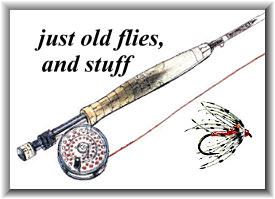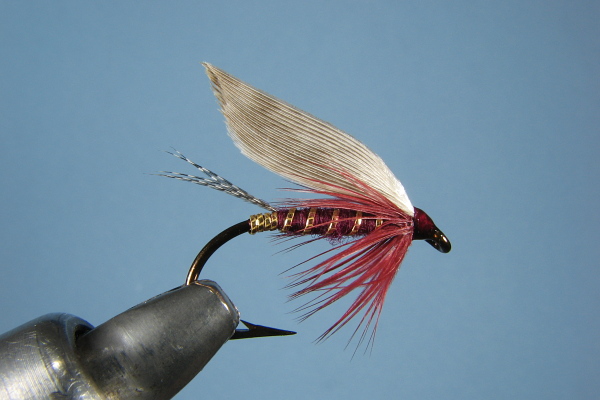
Welcome to 'just old flies,' a section of methods and flies that used-to-be. These flies were tied with the only materials available. Long before the advent of 'modern' tying materials, they were created and improved upon at a far slower pace than today's modern counterparts; limited by materials available and the tiers imagination.
Once long gone, there existed a 'fraternity' of anglers who felt an obligation to use only the 'standard' patterns of the day. We hope to bring a bit of nostalgia to these pages and to you. And sometimes what you find here will not always be about fishing. Perhaps you will enjoy them. Perhaps you will fish the flies. Perhaps?
BROUGHAM'S CLOWHOLM

This is a fly I've wanted to do for some time. It's listed among the Coastal Trout Patterns in the book Fly Patterns of British Columbia. This is a fascinating little book detailing the flies and history of B.C., and the history of fly fishing up there parallels our own to a large extent. We had our Ray Bergman, they had their Roderick Haig-Brown. We had our Herbie Welch up in Maine creating streamers; they had their Bill Nation at Paul Lake in the Kamloops area doing the same. As our streams degraded as a result of industrialization and the onslaught of civilization, so did theirs. Our flies began with a heavy British influence but soon evolved into ones better suited to the brook trout, and the Canadian flies also changed to brighter ones with more flash and color. Brougham's Clowholm is just such a fly.
The fly as depicted in Arthur James Lingren's book is quite beautiful, though the proportions are unusual (very short tail), and I hope I've done it justice. He took the fly from the frontispiece of W. F. Pochin's Angling and Hunting in British Columbia, a book written in 1946. I was at first quite taken with the strange name, and had to know more. It seems the fly was invented by Wilfred Brougham for cutthroat, probably in the early 1900s, as he immigrated to Canada from Great Britain in 1897. That explains the Brougham part of the name, what about the Clowholm? Well, the Clowholm, now known as the Clowhom, is a river that is located north of Vancouver which runs into the head of Salmon Arm, a branch of Sechelt Inlet. I've had a look at this on Google maps, and it looks as if it would have been quite tough to get to in the early 1900s. In fact, it looks as if the only good way to get to it now might be by bush plane. There is a road from Vancouver up to Sechelt, and I guess from there you could take a motor boat all the way up. Lingren says this in regard to the remote location: In those by gone days, the rivers and lakes of the province offered big catches to the fly fisher who ventured forth, often too difficult-to-get-to places. This fly's namesake is one such place.
Yes, Brougham's Clowholm fires the imagination, and one can only dream of fishing the Clowhom today. Brougham's fly had a small run of popularity and was sold locally by Harkley & Haywood of Vancouver. All I can say is that it's a lot of fun to tie, though I was unable to lay my hands on any off-white swan. I used some feathers given to me by a friend who picked them up around his pond. Here's the recipe:
Brougham's Clowholm
Materials
- Hook: Number 6 or 8 (I used a Mustad 3399)
- Tag: Oval, gold tinsel
- Tail: Teal flank fibers
- Ribbing: Oval, gold tinsel
- Body: Burgundy wool or seal's fur
- Throat: Burgundy Hackle
- Wing: Off-White swan
Credits: Fly Patterns of British Columbia by Arthur James Lingren; ~ ELA
[ HOME ]
[ Search ] [ Contact FAOL ] [ Media Kit ]